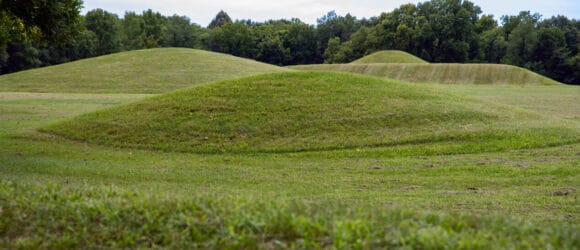Tumulus Tombs: The Predecessors of Modern Mausoleums
- At May 24, 2023
- By Lin McLeod
- In Mausoleum Design
 0
0

What is a tumulus? A tumulus is an artificial mound of earth and stones created to cover one or more graves. These burial mounds serve more than a practical function; they are meant to honor and remember the deceased.
Let’s discuss the origin of the word tumulus, the history of this type of burial, and where you can visit one. We will also discuss modern burial options.
The Origin of the Word Tumulus
Tumulus is Latin, meaning “mound” or “small hill.” The prefix tum means “to bulge” or “to swell.” Other related English words include tomb, thumb, and tumor.
How Ancient Burial Mounds Were Made
Ancient burial mounds were formed over buried graves. First, the bodies were buried in the ground, and then the tumulus would be built on top using available stones and soil.
However, in some regions, a stone or wooden burial chamber was first built. These rudimentary mausoleums would then be covered with sod and debris.
Burial mounds also sometimes housed the cremated ashes of the deceased in areas where cremation was preferred.
Where You Can See Burial Mounds
Burial mounds have been used since the Neolithic Period – or earlier. The practice of building burial mounds has been used around the world by numerous cultures. For example, the Hopewell and Adena people of North America were mound builders. Tumuli can be found in China and Japan. (In fact, the period between the third to sixth centuries is sometimes referred to as “the Tumulus period.”)
While some burial mounds have been lost, you can still visit surviving mounds worldwide.
Korea Burial Mounds
In the past, Koreans buried the dead in upright coffins under burial mounds. The burial mound site was vital, as a suitable place guaranteed good fortune and happiness for the offspring of the deceased. But such sites have been exhausted, and other burial practices are now used.
Giant Tumulus in Greece
The Kasta Tomb, or the Amphipolis Tomb, is Greece’s largest ancient burial chamber. The quality of this tomb indicates it contained important people.
Royal Mounds of Gamla Uppsala
The Royal Mounds of Gamma Uppsala are in Sweden. The mounds date back to the fifth and sixth centuries. Although it is unclear who was buried under the mounds, most researchers are convinced that this was the burial site of people of royal distinction.
Many burial mounds are said to have represented royal burials.
Effigy Mounds
Animal-shaped effigy mounds were constructed in many Native American cultures. In fact, over 3,200 animal-shaped effigy mounds have been identified in the upper Midwest. Native populations also used conical mounds, ridge-top mounds, and platform mounds.
Lydian Tumuli Sites
Visitors to modern Turkey will find some of the biggest specimens of artificial mounds—the famous Commagene tumulus on Mount Nemrut in Southeastern Anatolia. You will find the burial mounds marked with a column topped by an eagle.
There are other Lydian tumuli sites around the Eşme district of Uşak province. Unfortunately, raiders plundered some of these sites in the late 1960s, and the treasures found in their burial chambers were smuggled to the US.
All Cannings Barrow
You can visit Slavic barrow sites and mounds in ancient Thracian capital cities. You can see Indian mounds in North America and a mound belonging to King Gyges.
While ancient peoples built prominent tumuli, there is one example of a modern burial mound in the UK.
Work began on the All Cannings Barrow in 2014. This Neolithic-style barrow was split into multiple chambers, each containing about 300 cremation urn niches. Unfortunately, the niches sold out quickly.
Is There Another Modern Equivalent of a Burial Mound?
Except for the All Cannings Barrow, there are few modern burial mounds. This may be disappointing as many people interested in unique burial rituals may be attracted to this ancient form.
If you are looking for a distinguished burial site, consider constructing a private family mausoleum.
Much like the famous tumuli highlighted in this article, private family mausoleums often celebrate lives of distinction. Forever Legacy can help you create a beautiful, contemplative place for your family to reflect, meditate, or pray.
Key Takeaways: What is a Tumulus?
- A tumulus (plural tumuli) is an artificial mound that covers a grave or graves. Sometimes a tumulus marks the burial site of a distinguished person.
- There are many ancient burial sites that you can visit throughout the world.
- Consider a private family mausoleum if you are looking for a unique way to celebrate the life of a distinguished family.

